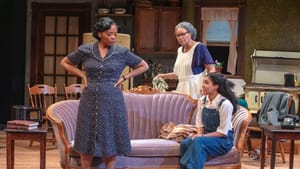Stay in the Loop
BSR publishes on a weekly schedule, with an email newsletter every Wednesday and Thursday morning. There’s no paywall, and subscribing is always free.
Still asking stark questions
Pennsylvania Shakespeare Festival presents Lorraine Hansberry’s A Raisin in the Sun

There are few plays that feel so ingrained in the American consciousness as Lorraine Hansberry’s A Raisin in the Sun. More than 60 years on, the script remains a live wire, sparking with righteous anger and uncommon tenderness. It is so thrillingly alive, so dramatically sound, that even when a particular production finds itself occasionally out of step—as with the Pennsylvania Shakespeare Festival’s (PSF) current staging—it still courses with Hansberry’s raw humanistic power.
Directed by Akeem Davis, PSF’s A Raisin in the Sun presents the Younger family with loving attention to detail: a Black working-class family in the 1950s, crammed into a small South Side Chicago apartment. Walter (Brandon E. Burton) dreams of starting his own business; Lena (Kimberly S. Fairbanks), his mother, of buying a new house; Beneatha (Billie Wyatt), his sister, of becoming a doctor. When they receive an insurance check for their recently deceased patriarch, their dreams seem one step closer to reality.
Yearning, disdain, passion, and pathos
To stage a successful Raisin is to capture its family dynamic, which the cast achieves to remarkable effect. Burton animates Walter with an intense yearning, rooting about the stage as if in constant search of escape without shrinking from the character’s periodic cruelty. Just as his dreams can fuel his ambitions, they can also curdle into disdain for his wife, sister, and mother, an ugliness which Burton fearlessly embraces. Noelle Diane Johnson, as Walter’s wife Ruth, provides a finely wrought counterbalance, firmly tethered to the earth. In her ceaseless domestic duties and care for their son, Travis (Kian E. Cooper, wide-eyed and wondrous), she seems to shoulder the weight of both their lives.
Fairbanks’s Lena summons a similar pathos, watching the potential dissolution of her family and trying to mend it as best she can. More than anyone else, she is the play’s indomitable spirit incarnate. Wyatt’s Beneatha is suitably impassioned, in college and trying to reconnect with her African heritage, if somewhat out of sync with the rest of the cast. True, Beneatha is the youngest adult in the family, but Wyatt’s mannerisms stray into the overly modern, clashing with the play’s otherwise period sensibilities. She finds her most compelling moments when going toe-to-toe with her suitors, the wealthy George Murchison (Jamir Fisher) and the idealistic Joseph Asagai (Isaiah Caleb Stanley), wielding her passion as a mask for her doubt.
Uneven design elements
Scenic design by Marie Laster and lights by Thom Weaver work to create an exquisite period atmosphere. The set is drawn with a painterly quality and frequently lit with soft, sunny hues, conjuring the unreal quality of an old photo. But other technical elements are less successful.
Sound design (by Jordan McCree) undercuts the illusion. During scene transitions, a fusion of voices reading Langston Hughes’s “Harlem” (the poem from which the play draws its title) sounds out, echoing with a reverb effect. The flashiness of the audio conflicts with the 1950s setting, taking you out of the scene entirely, dulling many a final dramatic beat. This frame device culminates in a flourish of light and sound that attempts to connect the Youngers’ struggles with modern-day police brutality: an interesting idea, but one that blunts the play’s closing moments with its showy execution.
A handful of other scenes are impeded by their blocking and pacing. Several sequences take place flatly upstage, while others, such as Walter’s drunken fantasy of being an African chief, unfold with a strangely hesitant tenor.
Optimism and realism
And yet, even with these occasional missteps, the show still sings for its bittersweet spirit, its optimism that refuses to exist absent a sobering realism. Even in its final triumphant sequence, when Walter stands up to Karl Lindner (Matt Pfeiffer), the racist white representative of Clybourne Park, and asserts his family’s right to live where they please, it is, necessarily, a temporary victory. The Youngers will go on to move into an all-white neighborhood and contend with further bigotry there. (When Hansberry’s own family moved into an all-white neighborhood in 1937, an angry mob assembled and launched a brick through their window.) Dreams will be colored inevitably by reality.
Is this enough? Can it be? This is the question that imbues A Raisin in the Sun with its staying power, as stark and unshakable as it’s ever been.
What, When, Where
A Raisin in the Sun. By Lorraine Hansberry, directed by Akeem Davis. $25-$65. Through July 13, 2025, at the Pennsylvania Shakespeare Festival’s Labuda Center for the Performing Arts, 2755 Station Avenue, Center Valley. (610) 282-WILL or pashakespeare.org.
Accessibility
The Pennsylvania Shakespeare Festival box office is able to accommodate requests for a wheelchair or companion seat, space for a service animal, a large-print program, or a headset for the assisted listening system. There will be an audio-described performance of A Raisin in the Sun on Saturday, July 12, at 2pm.
Sign up for our newsletter
All of the week's new articles, all in one place. Sign up for the free weekly BSR newsletters, and don't miss a conversation.

 Kiran Pandey
Kiran Pandey